The Best of Rudy Rucker Bundle from Jason Chen includes twelve volumes. I describe the bundle on Jason’s site, and I also describe the bundle on this blog post. On this post, I descrbe them chronologiccally, then I excerpt some reviews.
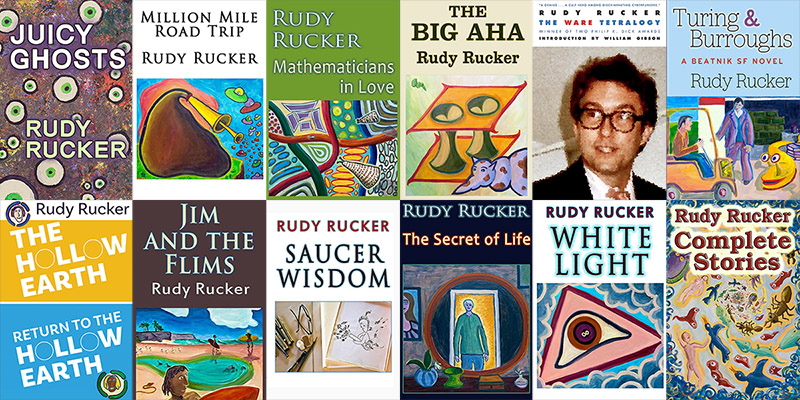
In 1972 I wrote my Ph. D. thesis on the mathematics of higher infinities—and turned it into a novel about the transfinite afterworld: White Light. It was also an SF novel about Rudy’s my life—which is something I like to do. I call it transrealism.
Soon after this, on a research grant in Heidelberg with my young family of five, I stzrted my well-known cyberpunk tetralogy Software, Wetware, Freeware, and Realware—an early example of digital immortality. I won the Philip K. Dick Award for Software and for Wetware.
You might say The Secret of Life marks my coming out as an alien. As my character faces his true nature, he takes on a series of awesome powers. He can change his face, shrink to the size of a thumb, fly around the Eiffel tower—and hand out joints to everyone at his college’s annual student assembly. And this is important because government snipers are out to kill him. Why did youth rebel in the 60s? This SF transreal novel will help you understand how it happened.
In Mathematicians in Love, I return to his roots. Two young mathematicians compete for the love of two women across space, time and logic—spinning out Dr. Seuss-like mathematical mumbo jumbo along the way. Berkeley grad students Paul and Bela have discovered the mathematical underpinnings of ultimate reality. Bela starts a wild rock band. And Paul hacks fundamental reality. But there are side effects.
Another combo volume: The Hollow Earth and Return to the Hollow Earth, one of my most demented—yet logical—constructs. Earth is hollow, like a tennis ball. And you’re weightless in there! The gravity cancels out. The wondrous Hollow Earth holds jungles, seas, native tribes, flying pigs, killer nautiluses, giant ants, live flying saucers, and giant sea cucumbers. In The Hollow Earth, our young narrator Mason Reynolds leaves his farm, accompanied by Otha and the dissolute Edgar Allan Poe—and falls through a thousand-mile hole in the ice of Antarctica. And when Return to the Hollow Earth ends, they’re in modern-day Santa Cruz, California.
Saucer Wisdom is the ultimate transreal extravaganza. Some nut is taking trips to the future in a UFO, and bringing back reports for Rudy Rucker to write up? Yes, I’m one of the characters. Profusely illustrated with line drawings. And with two prefaces by Bruce Sterling.
The surfing SF novel Jim and the Flims is set in Santa Cruz, California . . . and in the afterlife. Jim Oster ruptures the membrane between our world and afterworld, creating a two-way tunnel between them. His wife is killed in the process. And now Jim faces an invasion of the aliens—who resemble blue baboons and flying beets. Aided by a posse of Santa Cruz surf-punks, Jim plunges into a mad series of adventures in the underworld—where he just might find his wife. Jim and the Flims is like classic myth retold for the 21st century. Except that it’s funny.
Turing & Burroughs. What if Alan Turing, founder of the modern computer age, escaped assassination by the secret service to become the lover of Beat author William Burroughs? What if they mutated into giant shapeshifting slugs, fled the FBI, raised Burroughs’s wife from the dead, and tweaked the H-bombs of Los Alamos? Welcome to Turing & Burroughs, A Beatnik SF Novel, compulsively readable, hysterically funny, with insane warps and twists—and a bad attitude throughout.
The Big Aha. Biotech has replaced machines. Qrude artist Zad works with living paint. His career’s on the skids, and wife Jane threw him out. Enter qwet—it’s quantum wetware! Qwet makes you high and gives you telepathy. A loopy psychedelic revolution begins. Zad and Jane travel through a wormhole and meet the aliens. Stranger than you ever imagined. What is The Big Aha?
Million Mile Road Trip is my hilarious, and uniquely gnarly science fiction version of the classic road-trip story. When a seemingly-innocent trumpet solo opens a transdimensional connection to a parallel universe containing an endless plain divided into basin-like worlds, three California teens take a million-mile road trip across a landscape of alien civilizations in a beat-up, purple station wagon— with a dark-energy motor, graphene tires and quantum shocks. Their goal? To stop carnivorous flying saucers from invading Earth. And, just maybe, to find love along the way.
Complete Stories. Every one of my science-fiction stories, a trove of gnarl and wonder, from 1976 through 2022. Includes collaborations with Bruce Sterling, Marc Laidlaw, Paul Di Filippo, John Shirley, Terry Bisson, and Eileen Gunn. Ninety-six tales in all.
And—Juicy Ghosts. Telepathy, digital immortality, gossip molecules, and artificial ghosts, set amid a pitched battle to oust the evil forces of the nanopercenters, the Citadel Club, the Top Party, and the falsely elected President Ross Treadle. Rudy’s wildest world yet.
For StoryBundle, you decide what price you want to pay. For $5 (or more, if you’re feeling generous), you’ll get the basic bundle of four books in any ebook format—WORLDWIDE.
- Mathematicians in Love by Rudy Rucker
- The Ware Tetralogy by Rudy Rucker
- Million Mile Road Trip by Rudy Rucker
- Juicy Ghosts by Rudy Rucker
If you pay at least the bonus price of just $20, you get all four of the regular books, plus EIGHT more books, for a total of 12!
- Complete Stories by Rudy Rucker
- White Light by Rudy Rucker
- The Secret of Life by Rudy Rucker
- Saucer Wisdom by Rudy Rucker
- Jim and the Films by Rudy Rucker
- Turing & Burroughs by Rudy Rucker
- The Big Aha by Rudy Rucker
- The Hollow Earth & Return to the Hollow Earth by Rudy Rucker
This bundle is available only for a limited time via StoryBundle. You get multiple DRM-free formats (.epub, .mobi) for all books!
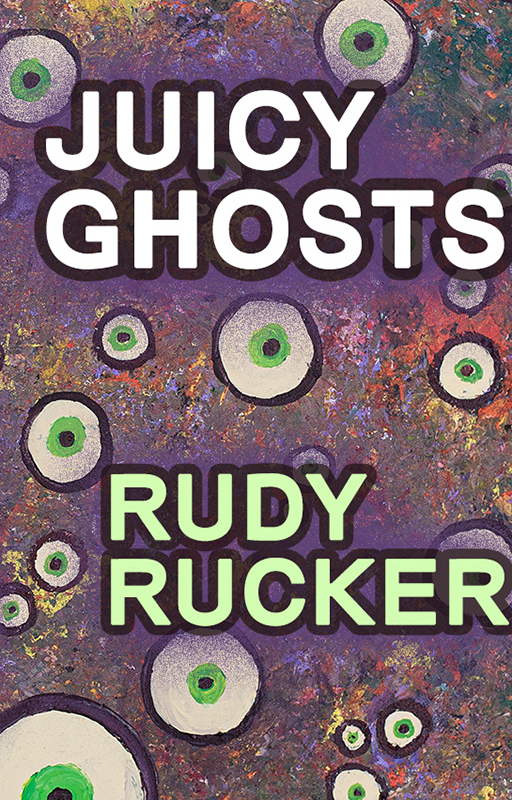
#1. Juicy Ghosts, 2021.
“Rudy Rucker’s great new novel, Juicy Ghosts, represents a wise man working at the peak of his powers. Ripe with satire, humor, empathy and tough-minded political hardball, this book exhibits all the shining Rucker talismans, from telepathy to immortality, from gonzo shenanigans to chaotic redemption. With a stellar cast of high-tech lowlifes, male and female both, dialogue that crackles and amuses, and a fire in its belly, Juicy Ghosts outlines a path into our mutual future that is painted in rainbow bioluminescent neon colors.” — Paul Di Filippo.
“Juicy Ghosts is some of Rudy’s best stuff, it flows wonderfully, and the characters are great. A thing of absolutely breakneck pace, with high energy throughout. Nonstop insanity.” — Marc Laidlaw, author of The Gargoyle’s Handbook and writer of the videogame Half-Life.
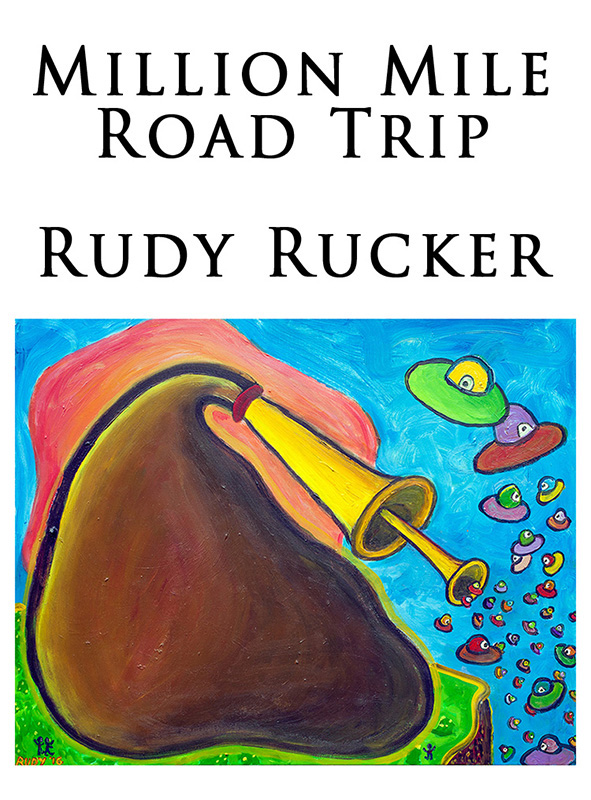
#2. Million Mile Road Trip 2019.
“There’s an alien under the bed and another on the lawn. This is Los Perros, Calif. — playground for Rudy Rucker, setting for his newest novel, Million Mile Road Trip. And things are only going to get stranger from here. What it cooks down to is music. What it cooks down to is a jubilant looseness. A freak collision of dialect and voice and neurons well-greased, and a man who wants to tell a story about three teenagers going on a road trip through alien worlds without leeching any of the inherent strangeness from it. This kind of thing, you just jump in and hang on, warmed by the goofball joy of it all, buoyed up by the high, jazz-cat bebop of the language, the glazed stoner rhythms. And by the end of it, your mind will be inevitably expanded — open to the possibility of almost anything.” — NPR Review
Tipping his hat to Thomas Pynchon, Jack Kerouac, and Douglas Adams, Rucker immerses readers in a fantastical road trip adventure that’s a wild ride of unmitigated joy. Rucker populates his story with boldly surreal, humorous personalities and environments and moves it at a frenzied, ever-increasing pace. He ties everything together with internal consistency, playful use of language that keeps his ideas alien yet accessible, and a solid grounding in fourth-dimensional math. This wacky adventure is a geeky reader’s delight. —Publishers Weekly
Rucker has outdone himself in creating the most bizarre and surreal and overstuffed cosmic ecology of his career. The vast majority of the concepts are brand new. And the abundance of alien characters is the richest yet of his oeuvre. Yes, it’s all obvious now—Rucker is Lennon & McCartney rolled up into one. — Paul Di Filippo in Locus Online
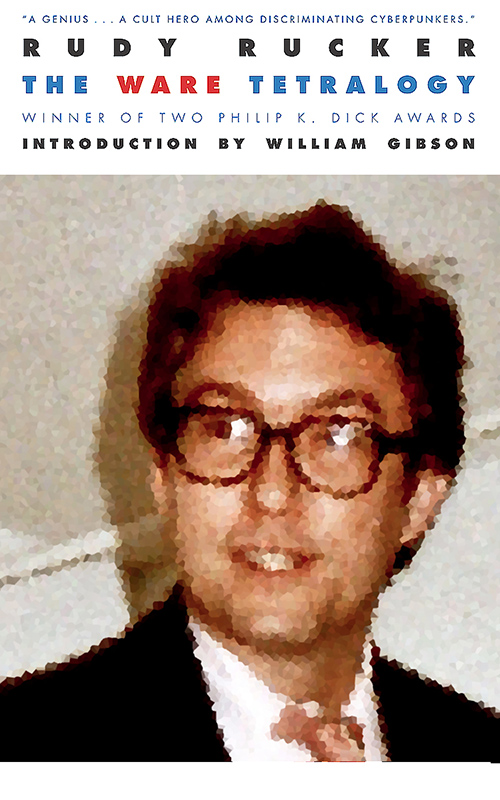
#3. The Ware Tetralogy 1982, 1988, 1997, 2000.
“Rudy Rucker is one of the modern heroes of science fiction, one of the original cyberpunks. The early cyberpunks only had a few writers who could be meaningfully called punks — writers like John Shirley and Richard Kadrey — but there was only one who could truly be called cyber: Rudy Rucker. Rucker is a mad professor, a mathematician and computer scientist with a serious, scholarly interest in the limits of computation and the physics and mathematics of higher-dimension geometry. But that’s just about the only thing you can describe as “serious” when it comes to Rucker. He’s a gonzo wildman, someone for whom “trippy” barely scratches the surface. His work is shot through with weird sex, weird drugs, weird brain chemistry, and above all, weird science.” — Cory Doctorow
Rucker’s writing is great like the Ramones are great: a genre stripped to its essence, attitude up the wazoo, and cartoon sentiments that reek of identifiable lives and issues. Wild math you can get elsewhere, but no one does the cyber version of beatnik glory quite like Rucker. Rucker does it through sheer emotional force. It’s not his universes, it’s his people and how they relate to each other — and to the spiritual. That’s what Realware has going for it: healing and a calm sense of spirituality. — New York Review of Science Fiction.
Reading a Rudy Rucker book is like finding Poe, Kerouac, Lewis Carroll and Philip K. Dick parked on your driveway in a topless ”˜57 Caddy … and telling you they’re taking you for a RIDE. The funniest science fiction author around. — Sci-Fi Universe.
Rucker has written a generational saga that spans sixty years of mind-blowing change. Without sacrificing any of his id-driven wildness, Rucker has developed into a benevolent, all-seeing creator … Realware brings to a fully satisfying conclusion this landmark quartet. — Isaac Asmiov’s Science Fiction Magazine.
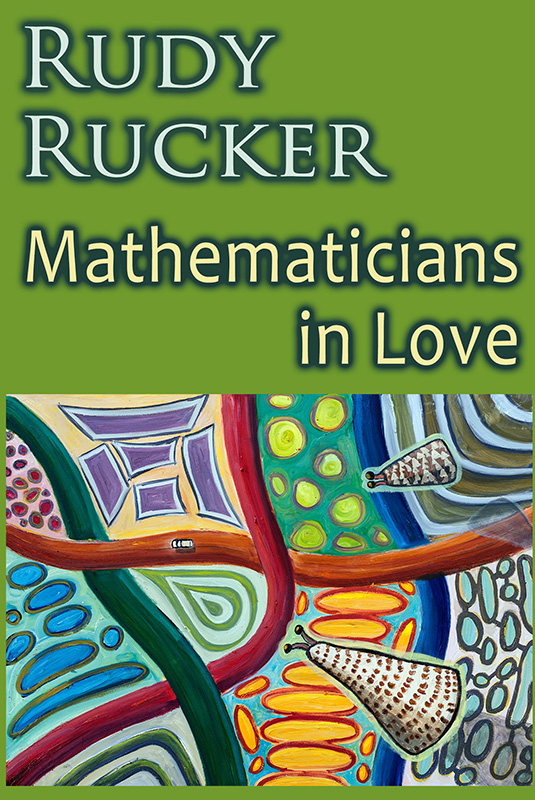
#4. Mathematicians in Love, 2006.
“Rucker cleverly pulls off a romantic comedy about mathematicians in love. This excursion into alternative versions of Berkeley, California, is full of quirky, charming life-forms human and otherwise and ruled by a god who’s the female jellyfish-creator of Earth. All this seethes around Bela Kis; Bela’s roommate, Paul Bridge; and Bela’s girlfriend, Alma Ziff, who ping-pongs between them in a sometimes acute, sometimes obtuse love triangle. Bela and Paul struggle for their PhD degrees under mad math genius Roland Haut by inventing a paracomputer ‘Gobubble’ that predicts future events. Rucker’s wild characters, off-the-wall situations and wicked political riffs prove that writing SF spoofs, like Bela’s rock music avocation, ‘beats the hell out of publishing a math paper.’ “ — Publisher’s Weekly
Mathematicians in Love … percolates with off-the-wall characters and trippy extra-dimensional shenanigans. Nobody writes math-based science fiction like Rudy Rucker does. He keeps the tone light and the action playful, even as his characters grapple with the meaning of tragedy and the ultimate mechanics of the universe. A definite high point in Rucker’s singular writing career.— San Francisco Chronicle
All the pleasures of a Rucker novel come forth abundantly: playfully weird higher physics and math; bizarre conceptual psychedelia; distinctively Calfornian counter-cultural comedy; zany romance; doppelgangers; generally happy endings. … Mathematicians in Love is an engaging and entertaining book, light yet thought-provoking, funny yet of some gravity. It deserves success.— Locus
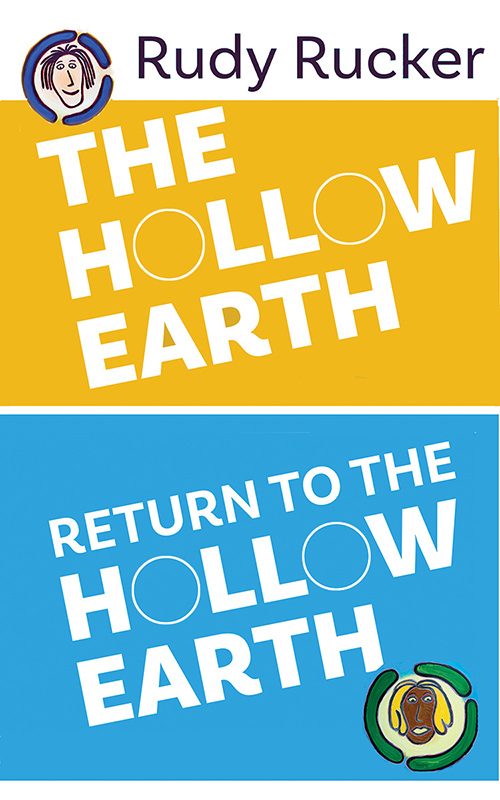
#5. The Hollow Earth & Return to the Hollow Earth 1990 & 2018.
“It’s more fun than anything I’ve read in I don’t know how long, and it’s certainly the reigning king of the ”˜hollow Earth’ novels. Rucker has an enviable imagination, an astonishing ear for language, and a rare sense of proportion and humor. I wish books like this would come along more often. — James P. Blaylock.
“Rudy has written the Great American Science Fiction Novel.” — Marc Laidlaw.
Rudy Rucker seldom repeats himself. Consequently, when Rucker does venture back to previously explored territory, you can be fairly confident that there’s good reason. This is certainly true in the current case, as he returns, after nearly thirty years, to the steampunk milieu of his 1990 novel The Hollow Earth. … The two books co-exist quite harmoniously, despite the large gap of years twixt their composition. The blending of typical Ruckerian cosmological insanity with 19th-century mindsets proves to be a stimulating concoction. Toss in some time-travel frissons at the end, when some metafictional stagecraft happens, and you have a book that is dense with the kind of intellectual “eyeball kicks” for which Rucker is justly famous. It’s a tribute to the wild-eyed tales of Poe and his peers that is also an up-to-the-minute 21st-century SF production. — Paul Di Filippo in Locus Online
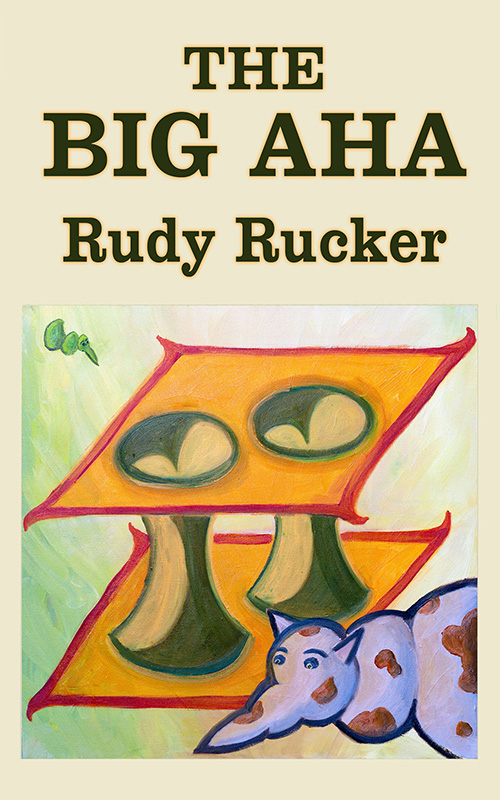
#6. The Big Aha, 2013.
“The Big Aha gloriously and objectively exists on an absolute level with all of Rucker’s classic work, chockfull of crazy yet scientifically rigorous ideas embodied in gonzo characters and plots. Like a jazzman, Rucker takes his intellectual obsessions as chords and juggles them into fascinating new patterns each time out. A rollercoaster ride that is never predictable and always entertaining. Straight out of some Kerouac or Kesey novel, yet with a twenty-first century affect. Rucker is remarkably attuned to a new generation. Ultimately, all the craziness and whimsy and otherworldly menaces of Zad’s mad odyssey induces true pathos and catharsis in the reader.” — Paul Di Filippo, Locus Online.
Rudy Rucker’s latest novel, The Big Aha, is pure transreal Ruckeriana featuring extreme biological and quantum technologies, steamy techno-sex, nasty aliens from higher dimensions — and all soaked in the unique atmosphere of the magical 1960s.… This is a great example of how science fiction publishing is being redefined. — Giulio Prisco, io9.
Rucker has been writing like a mind-meld of Gödel and Burroughs on acid, but with some sort of academic overmind trying, and for the most part succeeding, to run the result through a logical scientific-refereed-paper process… But there is something else to this novel, a characterological sweetness combined with a political passion the nature of which might cause Rucker to deny that it is political… What Rudy Rucker presents and champions is the last and finally successful battle in the culture war dating back to the Transcendental Movement of the nineteenth century that peaked in the 1960s. — Norman Spinrad, Isaac Asimov’s SF Magazine.
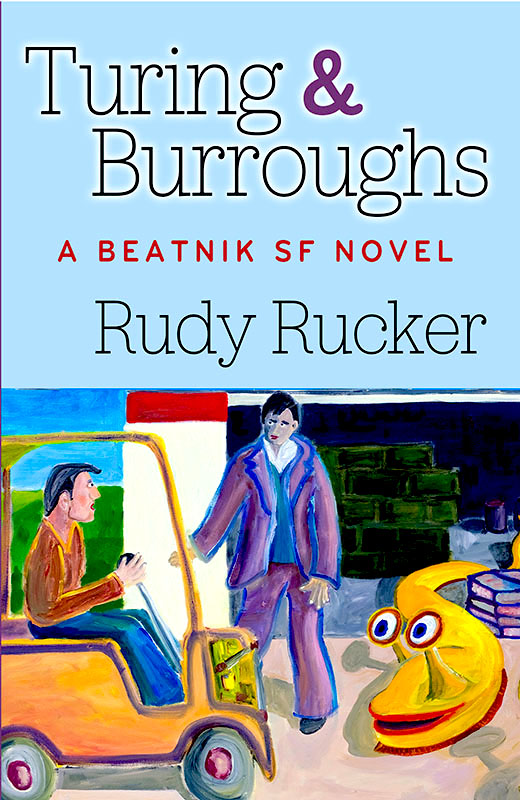
#7. Turing & Burroughs, 2012.
“Rucker’s novels have an angle of attack reminiscent of the Thomas Pynchon of Gravity’s Rainbow and the Terry Southern of The Magic Christian. Turing & Burroughs is all of that and more. Much more. Turing & Burroughs is centrally the story of an imaginary gay affair between William Burroughs and Alan Turing. Rucker being Rucker, this central story line is not even half the bizarre, fascinating, scientific, sexual, and historical content of this delightfully humorous yet somehow thematically serious novel.” — Norman Spinrad, Asimov’s SF Magazine
A delightful alternative history romp set in the middle of the 1950s. Rucker immerses the reader in the beat milieu, with the added twist that here they really are pod people, and loving it.… This novel engages the reader to such an extent that it’s easy to overlook the extensive research that went into making it authentic, not just superficially, but in depth. — John Walker, review in Fourmilog.
Rucker’s “Beatnik SF Novel” deftly combines historic characters and wild flights of imagination in a spin-off of our world’s history.… Rudy Rucker has produced an SFnal tour de force.… The prose in Turing & Burroughs can flow like a drug-stoked dream. — Faren Miller, review in Locus Magazine
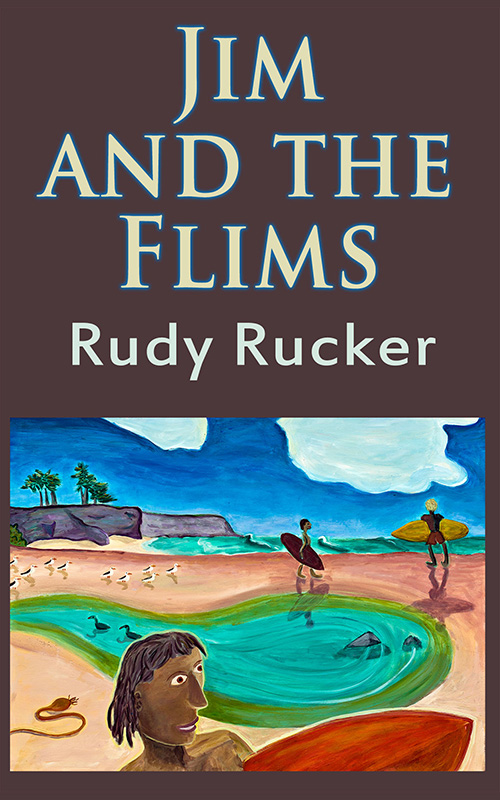
#8. Jim and the Flims, 2911.
“Jim and the Flims is a wild psychedelic romp that recasts the myth of Orpheus and Eurydice in the 21st century surf-punk/slacker world of Santa Cruz and its earthly and extra-earthly environs. Hilarious, profound, visionary, and genuinely moving, it vaults to the top spot on my list of favorite Rudy Rucker novels… A key component of Rucker’s genius, it seems to me, lies in his ability to tackle his subjects on a multitude of levels simultaneously. There’s a fractal beauty to it. If you’re just into a weird and funny story, you’ve got it. If you dig mythic resonance—look no further. If theoretical physics is your bag, Rucker’s witty allegories will delight you. Philosopher, Phil Dick fan, armchair theologian: there’s something to challenge, satisfy, and delight any alert, intelligent reader.” —Paul Witcover, Locus
Jim and the Flims…Rudy Rucker’s weirdest, craziest, colorfulest book yet? That’s saying a lot, I know. But when it is at its most bizarre, it is also most hilarious. Nobody else writes like Rudy. —Marc Laidlaw, author of Kalifornia
I love Rudy Rucker. The guy is simply incomparable when it comes to writing science fiction, managing to seamlessly blend highly intelligent existential and scientific speculation with wildly satirical and insanely imaginative plotlines…You can imagine my delight when a copy of his newest release, Jim and the Flims, landed on my doorstep. In this novel, Rucker reimagines the myth of Orpheus as only he can ”“ Jim Oster is a former surfer dude, part-time stoner, and current Santa Cruz mailman who dabbles in high-tech research. —Paul Goat Allen, review on Barnes & Noble Book club
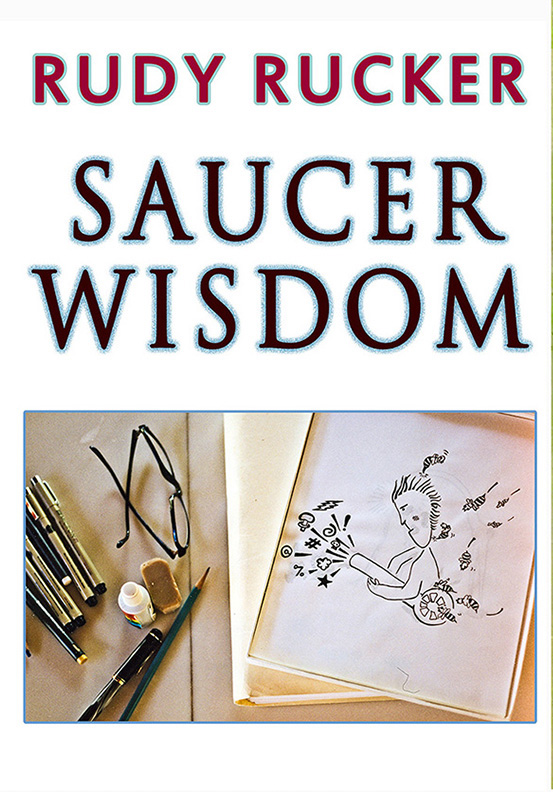
#9. Saucer Wisdom, 1999.
With two prefaces by Bruce Sterling.
“It’s brilliantly funny, prescient, and as fully engaging as a coffee-fueled late-night conversation with a slightly manic genius. From the aloof-yet-naughty aliens … to the detailed, personalized visions of future people’s technology, Saucer Wisdom shines with a humanity firmly rooted right here on Earth… It seems that ”˜the William S Burroughs of cyberpunk’ can’t help but write good books.” — Amazon.com.
With Saucer Wisdom Rucker has reached a new peak. Saucer Wisdom is absolutely one of the best books of the year. Rucker has … grown up, elucidating the wild-eyed, gonzo ideas of his youth with the clear-eyed, well-honed craft of a mature writer at his creative peak. — NOVA Express.
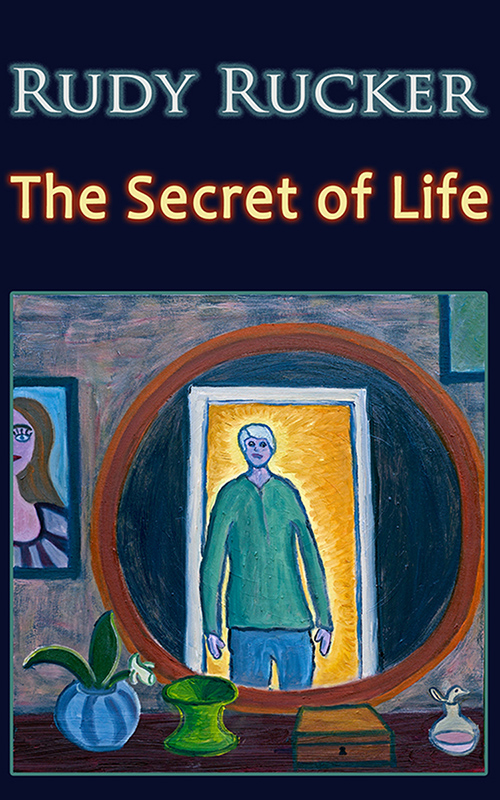
#10. The Secret of Life, 1985.
“Rucker is an artist well worth discovering, reading, and keeping up with. The Secret of Life sparkles with deadpan wit and a natural storyteller’s flair, blending mathematical speculation, such concepts as Hilbert space, rock’n’roll, drugs, and sex with imaginative ideas worthy of H. G. Wells.” — Washington Post Book World.
One of the writers we will follow into the new future. — Raleigh Spectator.
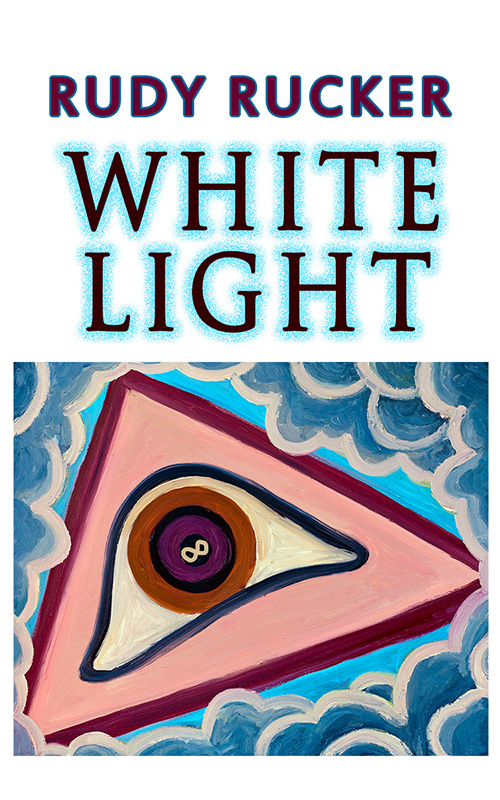
#11. White Light 1980.
“In White Light Rucker commandingly synthesizes mysticism, pop imagery, the great mathematicians and their ideas, ”˜head culture,’ and even voodoo into a novel that takes us on a wild journey to infinity, to the Absolute, and back again. As for sheer writing, there’s probably no one like him.” — John Shirley.
“White Light is a marvelously inventive and lunatically logical story, where not only is the scaling of infinity a mad, convincing adventure, but where ordinary human happiness matters too movingly.” — Ian Watson in Vector.
“An adventure through time and space, the likes of which only a collaboration between Umberto Eco and Lewis Carroll could attempt. With traveling companions ranging from Einstein to the devil to a giant beetle named Franx…each turned corner of White Light is another gleeful surprise, another celebration of cleverness and imagination… This novel belongs to the tradition of science fiction pioneered by H. G. Wells, where the science is the source of intrigue that adventures grow from and propel the protagonists.” — Amazon editorial review.
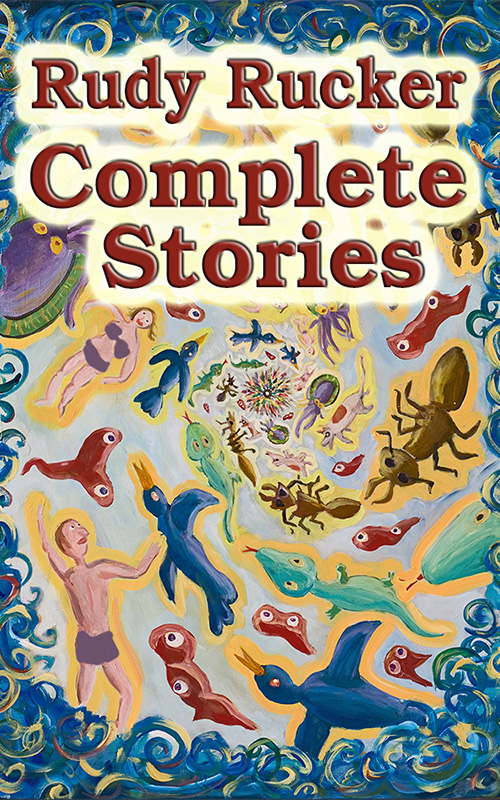
#12. Complete Stories, 1976-2022.
Every one of Rudy Rucker’s science-fiction stories, a trove of gnarl and wonder, from 1976 through 2022. Includes collaborations with Bruce Sterling, Marc Laidlaw, Paul Di Filippo, John Shirley, Terry Bisson, and Eileen Gunn. Ninety-six tales in all: “Jumpin’ Jack Flash,” “Enlightenment Rabies,” “Schrödinger’s Cat,” “Sufferin’ Succotash,” “A New Golden Age,” “Faraway Eyes,” “The 57th Franz Kafka,” “The Indian Rope Trick Explained,” “A New Experiment With Time,” “The Man Who Ate Himself,” “Tales of Houdini,” “The Facts of Life,” “Buzz,” “The Last Einstein-Rosen Bridge,” “Pac-Man,” “Pi in the Sky,” “Wishloop,” “Inertia,” “Bringing in the Sheaves,” “The Jack Kerouac Disembodied School of Poetics,” “Message Found in a Copy of Flatland,” “Plastic Letters,” “Monument to the Third International,” “Rapture in Space,” “Storming the Cosmos” (With Bruce Sterling), “In Frozen Time,” “Soft Death,” “Inside Out,” “Instability” (With Paul Di Filippo), “The Man Who Was a Cosmic String,” “Probability Pipeline” (With Marc Laidlaw), “As Above,” “So Below,” “Chaos Surfari” (With Marc Laidlaw), “Big Jelly” (With Bruce Sterling), “Easy As Pie,” “The Andy Warhol Sandcandle” (With Marc Laidlaw), “Cobb Wakes Up,” “The Square Root of Pythagoras” (With Paul Di Filippo), “Pockets” (With John Shirley), “Junk DNA” (With Bruce Sterling), “The Use of the Ellipse the Catalog the Meter & the Vibrating Plane,” “Jenna and Me” (With Rudy Rucker Jr.), “Lucky Number,” “The Million Chakras,” “Aint Paint,” “Terry’s Talker,” “The Kind Rain,” “Hello Infinity,” “MS Found in a Minidrive,” “Guadalupe and Hieronymus Bosch.” “The Men in the Back Room at the Country Club,” “Panpsychism Proved,” “Elves of the Subdimensions” (With Paul Di Filippo), “2+2=5” (With Terry Bisson), “Visions of the Metanovel,” “The Third Bomb,” “The Imitation Game,” “Hormiga Canyon” (With Bruce Sterling), “The Perfect Wave” (With Marc Laidlaw), “Tangier Routines,” “Message Found In A Gravity Wave,” “Qlone,” “Colliding Branes” (With Bruce Sterling), “Jack and the Aktuals” (Or,” “Physical Applications of Transfinite Set Theory), “All Hangy” (With John Shirley), “To See Infinity Bare” (With Paul Di Filippo), “Bad Ideas,” “Good Night,” “Moon” (With Bruce Sterling), “Fjaerland” (With Paul Di Filippo), “The Fnoor Hen,” “Hive Mind Man” (With Eileen Gunn), “My Office Mate,” “Yubba Vines” (With Paul Di Filippo), “Loco” (With Bruce Sterling), “I Arise Again,” “Apricot Lane,” “Where the Lost Things Are” (With Terry Bisson), “Laser Shades,” “Petroglyph Man,” “Attack of the Giant Ants,” “Water Girl” (With Marc Laidlaw), “Totem Poles” (With Bruce Sterling), “Like a Sea Cucumber,” “The Knobby Giraffe,” “Kraken and Sage” (With Bruce Sterling), “Emojis,” “@lantis” (With Marc Laidlaw), “Fat Stream,” “In the Lost City of Leng” (With Paul Di Filippo), “Surfers at the End of Time” (With Marc Laidlaw), “Juicy Ghost,” “Everything is Everything,” and “Fibonacci’s Humors” (With Bruce Sterling).
For more information, visit our the StoryBundle website.








